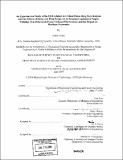| dc.contributor.advisor | Tian Tian and Henry Marcus. | en_US |
| dc.contributor.author | Vokac, Adam, 1978- | en_US |
| dc.contributor.other | Massachusetts Institute of Technology. Dept. of Mechanical Engineering. | en_US |
| dc.date.accessioned | 2005-09-06T21:54:13Z | |
| dc.date.available | 2005-09-06T21:54:13Z | |
| dc.date.copyright | 2004 | en_US |
| dc.date.issued | 2004 | en_US |
| dc.identifier.uri | http://hdl.handle.net/1721.1/27132 | |
| dc.description | Thesis (S.M.)--Massachusetts Institute of Technology, Dept. of Mechanical Engineering; and, (S.M.)--Massachusetts Institute of Technology, Dept. of Ocean Engineering, 2004. | en_US |
| dc.description | Includes bibliographical references (p. 191-194). | en_US |
| dc.description.abstract | Faced with increasing concern for lubricating, oil consumption and engine friction, it is critical to understand the oil transport mechanisms in the power cylinder system. Lubricating oil travels through distinct regions along the piston ring pack before being consumed in the combustion chamber, with the oil distribution and dominant driving forces varying substantially for each of these regions. This experimental work focuses on specific regions in the piston ring pack. A detailed 2D LIF (Two Dimensional Laser Induced Fluorescence) study has been performed on the oil distribution observed with the LIF generated real time high-resolution images, as were changes in piston and ring design. The results reveal the third land, located between the second compression ring and the oil control ring, oil flow patterns and timing are consistent and predictable at each operating point. Speed and load variation alter the basic flow pattern and oil balance through a corresponding change in inertia and gas dragging effect respectively, with ring design variation instigating specific and repeatable phenomenon onto the consistent oil flow pattern. Second land, the region between the top two compression rings, geometric and flow patterns throughout the entire cycle of a single cylinder spark ignition engine. The impact of speed and load were experimentally changes were found to have a significant impact on inertia driven oil transport; however, their effects on oil consumption were not as clear. As the majority of lubricating oil consumed in the engine crosses the third land at some point, an understanding of the timing and magnitude of the oil transport processes will allow means to be specifically developed to reduce the net oil flow across the third land | en_US |
| dc.description.abstract | (cont.) towards the combustion chamber. This work forms a foundation for developing oil control strategies for the third land and for identifying how and when oil reaches the upper piston ring pack regions that directly contribute to oil consumption. The ability to control, or impact, oil transport on the piston ring pack will have an impact on all engine classes, including engines in the maritime community. This experiment study is directly comparable to small marine engines, and can be used to help reduce maritime exhaust emissions related to lubrication consumption; additionally, this approach would be much more rugged and cost effective then other current technological improvements being investigated. Were a similar 2D LIF experiment to be performed on large slow speed diesel engifes, the annual savings per vessel, assuming only a 10% reduction in lube oil consumption was achieved, could amount to $30,000 as cylinder lube oil is one of the most expensive operating costs for large slow speed diesel engines. | en_US |
| dc.description.statementofresponsibility | by Adam Vokac. | en_US |
| dc.format.extent | 194 p. | en_US |
| dc.format.extent | 14835890 bytes | |
| dc.format.extent | 14862687 bytes | |
| dc.format.mimetype | application/pdf | |
| dc.format.mimetype | application/pdf | |
| dc.language.iso | en_US | |
| dc.publisher | Massachusetts Institute of Technology | en_US |
| dc.rights | M.I.T. theses are protected by copyright. They may be viewed from this source for any purpose, but reproduction or distribution in any format is prohibited without written permission. See provided URL for inquiries about permission. | en_US |
| dc.rights.uri | http://dspace.mit.edu/handle/1721.1/7582 | |
| dc.subject | Ocean Engineering. | en_US |
| dc.subject | Mechanical Engineering. | en_US |
| dc.title | An experimental study of the oil evolution in critical piston ring pack regions and the effects of piston and ring designs in an internal combustion engine utilizing two-dimensional laser induced fluorescence and the impact on maritime economics | en_US |
| dc.type | Thesis | en_US |
| dc.description.degree | S.M. | en_US |
| dc.contributor.department | Massachusetts Institute of Technology. Department of Mechanical Engineering | |
| dc.contributor.department | Massachusetts Institute of Technology. Department of Ocean Engineering | |
| dc.identifier.oclc | 56845532 | en_US |
